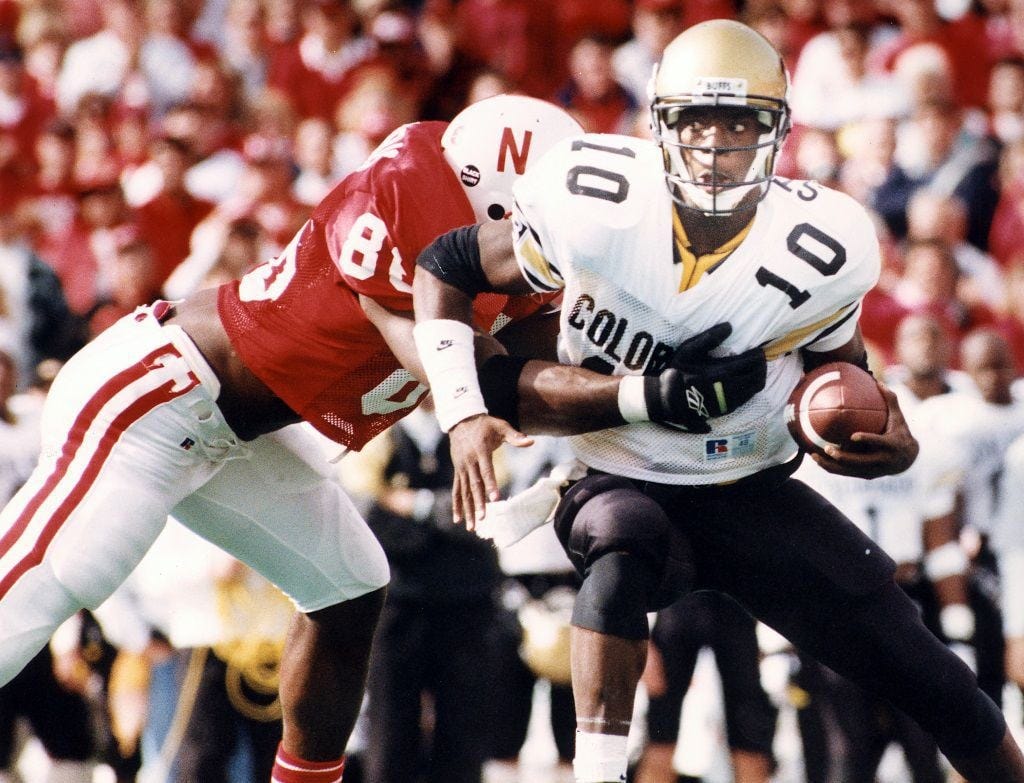How the Colorado-Nebraska rivalry was willed into existence
An idea Bill McCartney conjured up for a desperate program in the early 1980s became a must-see matchup for a generation of college football fans
Barring some sort of truly unforeseen event, more than 85,000 fans, the vast majority of them wearing red, will cram inside Nebraska’s Memorial Stadium Saturday and continue a sellout streak for the Cornhuskers that dates all the way back to 1962.
What will distinguish the program’s 398th consecutive capacity crowd from many of its predecessors is who its beloved team is playing against.
For a generation of college football fans, Nebraska and Colorado was a rivalry that helped define the sport. From the late 1980s until the mid-2000s, when both programs began to fade from national relevance, the Buffs and Huskers regularly took part in games that had a significant say in conference and national title races. In six of their eight matchups from 1989-96, both teams were ranked in the top 10. From 1988-95, at least one of the teams won the Big Eight Conference, including in 1991 when they split the honor. From 1990-97, they combined for four national championships.
After the rivalry was largely dormant during the 2010s thanks to the schools no longer sharing a conference, it will resume this weekend with the fourth meeting between Colorado and Nebraska since 2018.
Though the rivalry’s modern iteration hasn’t come with the same stakes – neither the Buffs nor the Huskers are expected to be viable threats for the College Football Playoff this year – it won’t be devoid of meaning. Deion Sanders and Colorado will look to turn the immense attention they’ve garnered over the past 21 months into more tangible on-field success while Nebraska continues to hope Matt Rhule can lead it back to something resembling its former glory. By the end of the day Saturday, one of those programs will be one step closer to reaching those goals.
Perhaps the most fascinating thing about the Buffs-Huskers rivalry isn’t its decorated past or its current place in the omnipresent Coach Prime melodrama.
It’s that it was literally built from nothing, a rivalry that was willed into existence.
How a rivalry was born from nothing
When Bill McCartney arrived at Colorado in June 1982, just three months before his first game of his first season as coach, he inherited a program in disrepair.
The Buffs had been solid, if not outright excellent in the late 1960s and for much of the 1970s, making seven bowl games in a 10-season stretch from 1967-76, winning 10 games in 1971 and making the Orange Bowl in 1976.
After losing five of its final six games after climbing as high as No. 13 in the Associated Press poll, Colorado fired coach Bill Mallory after the 1978 season, just two years after the Orange Bowl appearance and after Mallory went a respectable 35-21-1 over his five seasons on the job. He was replaced by Chuck Fairbanks, the former Oklahoma and New England Patriots coach who was the kind of big name university leadership believed could elevate its program. It didn’t quite work out that way. Fairbanks went 7-26 in three seasons with the Buffs and resigned seven months after the 1981 season ended to be the coach and general manager of the New Jersey Generals in the upstart United States Football League (where he was fired after one season when the team was purchased by a young real estate tycoon named Donald Trump.)
Fairbanks’ dismal record only told so much of the story when it came to Colorado’s woes. Ticket sales lagged, reflecting a broader sense of apathy that surrounded the program. Between its languishing major-revenue programs, Title IX expenses and the costly construction of a new arena, the university’s athletic department was working its way back from a $1 million debt.
McCartney quickly became acquainted with those obstacles, but there was something else that stood out to him – the program he was now tasked with shepherding didn’t have a rival.
Keep reading with a 7-day free trial
Subscribe to The Front Porch to keep reading this post and get 7 days of free access to the full post archives.




